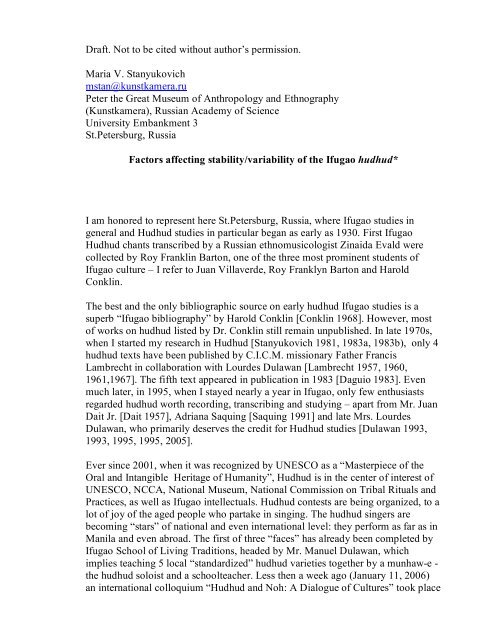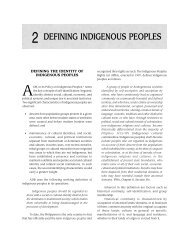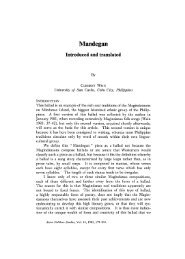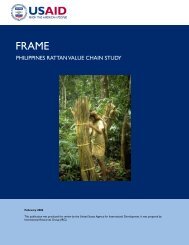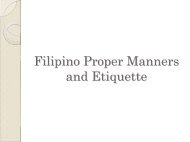The most ancient genres of oral literature date back - SIL International
The most ancient genres of oral literature date back - SIL International
The most ancient genres of oral literature date back - SIL International
You also want an ePaper? Increase the reach of your titles
YUMPU automatically turns print PDFs into web optimized ePapers that Google loves.
Draft. Not to be cited without author’s permission.Maria V. Stanyukovichmstan@kunstkamera.ruPeter the Great Museum <strong>of</strong> Anthropology and Ethnography(Kunstkamera), Russian Academy <strong>of</strong> ScienceUniversity Embankment 3St.Petersburg, RussiaFactors affecting stability/variability <strong>of</strong> the Ifugao hudhud*I am honored to represent here St.Petersburg, Russia, where Ifugao studies ingeneral and Hudhud studies in particular began as early as 1930. First IfugaoHudhud chants transcribed by a Russian ethnomusicologist Zinaida Evald werecollected by Roy Franklin Barton, one <strong>of</strong> the three <strong>most</strong> prominent students <strong>of</strong>Ifugao culture – I refer to Juan Villaverde, Roy Franklyn Barton and HaroldConklin.<strong>The</strong> best and the only bibliographic source on early hudhud Ifugao studies is asuperb “Ifugao bibliography” by Harold Conklin [Conklin 1968]. However, <strong>most</strong><strong>of</strong> works on hudhud listed by Dr. Conklin still remain unpublished. In late 1970s,when I started my research in Hudhud [Stanyukovich 1981, 1983a, 1983b), only 4hudhud texts have been published by C.I.C.M. missionary Father FrancisLambrecht in collaboration with Lourdes Dulawan [Lambrecht 1957, 1960,1961,1967]. <strong>The</strong> fifth text appeared in publication in 1983 [Daguio 1983]. Evenmuch later, in 1995, when I stayed nearly a year in Ifugao, only few enthusiastsregarded hudhud worth recording, transcribing and studying – apart from Mr. JuanDait Jr. [Dait 1957], Adriana Saquing [Saquing 1991] and late Mrs. LourdesDulawan, who primarily deserves the credit for Hudhud studies [Dulawan 1993,1993, 1995, 1995, 2005].Ever since 2001, when it was recognized by UNESCO as a “Masterpiece <strong>of</strong> theOral and Intangible Heritage <strong>of</strong> Humanity”, Hudhud is in the center <strong>of</strong> interest <strong>of</strong>UNESCO, NCCA, National Museum, National Commission on Tribal Rituals andPractices, as well as Ifugao intellectuals. Hudhud contests are being organized, to alot <strong>of</strong> joy <strong>of</strong> the aged people who partake in singing. <strong>The</strong> hudhud singers arebecoming “stars” <strong>of</strong> national and even international level: they perform as far as inManila and even abroad. <strong>The</strong> first <strong>of</strong> three “faces” has already been completed byIfugao School <strong>of</strong> Living Traditions, headed by Mr. Manuel Dulawan, whichimplies teaching 5 local “standardized” hudhud varieties together by a munhawe the hudhud soloist and a schoolteacher. Less then a week ago (January 11, 2006)an international colloquium “Hudhud and Noh: A Dialogue <strong>of</strong> Cultures” took place
in UP Diliman. Ngayaw (Domingo Dulnuan), a munhawe from Bangawwan,Duit, Kiangan, a small sitio which I consider my second home since 1995 – wasperforming with the chorus formed by other Kiangan dwellers. One <strong>of</strong> the positiveresults <strong>of</strong> such an activities is taping the hudhud for “publicizing” it. A publicationwhich was disseminated at “Hudhud and Noh” event contains 2 discs <strong>of</strong> hudhudsung by the same group, with their photographs (without names or references)inserted in an extract from Lambrecht’s 1957 hudhud publication [Hudhud.NCCAIHC 2005]. Previously published hudhud texts, <strong>most</strong>ly the Amador Daguioversion, was republished in several anthologies in Ifugao, English and even inTagalog translation. Two papers on hudhud appeared in the Philippines due to theefforts <strong>of</strong> Nicole Revel [Revel, Tourny 2003; Dulawan 2005].A certain amount <strong>of</strong> research papers on hudhud, largely unknown inside thePhilippines, appeared in the US, France and Russia [Menes 1996; Revel,Stanyukovich 2004; Stanyukovich 1996, 1997a, 1997b, 1998a, 1998b, 1999a,1999b, 2000, 2002, 2003a, 2003b, 2003c, 2004, 2005]. However, no newpublications** <strong>of</strong> hudhud texts was made during these years (apart from 2 pages byPatricia Afable [Afable 2005]). <strong>The</strong> text and translation <strong>of</strong> Alim, another Ifugaoritual chant which is <strong>of</strong> great importance to Hudhud studies, especially in respect toritual language, is still being prepared for publication by Rosario del Rosario[Rosario 2003].An alarming result <strong>of</strong> largescale activities around hudhud is a very fast formation<strong>of</strong> “censored” new code <strong>of</strong> hudhud, which will soon become an unquestionableauthority to be quoted by everybody.General sketch <strong>of</strong> this view on hudhud is as follows:1. <strong>The</strong>re is only one kind <strong>of</strong> hudhud – hudhud <strong>of</strong> rice, which is sung ondifferent occasions2. It is a strictly nonritual tradition used exclusively for entertainment3. Hudhud consists <strong>of</strong> 40 episodes and takes one or 2 nights to perform4. <strong>The</strong>re are regional variations that differ from each other in lexica onlyA valuable contribution <strong>of</strong> Arsenio Manuel that has put hudhud in ritual context <strong>of</strong>Philippine epics as early as in 1963 [Manuel 1963], as well as other importantPhilippine works on ritual functions <strong>of</strong> <strong>oral</strong> epics (Landa Jocano, Alicia Magos etal) seem to be totally neglected in hudhud studies nowadays.Surely we can talk about hudhud in general, as much as we can talk aboutPhilippine or Austranesian languages in general. However, XXI th c. requires amore detailed study that is, <strong>of</strong> particular hudhud <strong>genres</strong>, regional, ritual andsituational variations <strong>of</strong> hudhud. Otherwise we shall end up with a new Lennrot’s“Kalevala” or Longfellow’s “ Song <strong>of</strong> Hiawatha”, which is already on the way.
<strong>The</strong> <strong>most</strong> <strong>ancient</strong> <strong>genres</strong> <strong>of</strong> <strong>oral</strong> <strong>literature</strong> <strong>date</strong> <strong>back</strong> to the time when one ritualspecialist performed the functions <strong>of</strong> epic singer, shaman and priest. <strong>The</strong> Ifugaohudhud <strong>oral</strong> tradition belongs to the core <strong>of</strong> Southern and Central Ifugao ritual .<strong>The</strong> hudhud meets all the standards typical <strong>of</strong> heroic epic patterns, including theplot structure and formulaic style. In the same time it is a highly archaiccombination <strong>of</strong> heroic epics and shamanistic narratives. <strong>The</strong> hudhud characters areregarded as ancestors and incorporated into the male pantheon as part <strong>of</strong> Hulupeclass <strong>of</strong> benevolent deities.For research purposes we are to distinguish between hudhud proper, that is, theheroic epic, a story about ancestors and their exploits, and hudhudshaped ritualnarratives, that is, hudhud di kolot (hudhud <strong>of</strong> the haircut, a passage rite), hudhuddi nate (hudhud <strong>of</strong> the dead, funeral wake and bogwa –second burial ceremony)and, possibly, wedding hudhud (that last one I myself never heard or recorded andtherefore can not state positively that it really exists). <strong>The</strong>se ritual narratives usehudhud form (melody, way <strong>of</strong> performing, lexics, including personal names andplacenames, poetic structure and rhetorics) but actually treat not about heroancestors,but about certain members <strong>of</strong> Ifugao community, alive or dead, towhom personally the ritual is addressed. Not being epics, these additional <strong>genres</strong>are <strong>of</strong> vital importance internally and externally, that is, to the Ifugao traditionalcommunity and to ethnolinguistic/ ethnopoetic study <strong>of</strong> Ifugao hudhud. Fortraditional Ifugao community it was primarily these <strong>genres</strong>, marginal or additionalfor an epic student, that mattered. For example, it is a performance <strong>of</strong> the hudhuddi nate that requires the <strong>most</strong> skillful hudhud singer. Such a singer isknowledgeable in all the forms <strong>of</strong> hudhud and highly respected. In the same timethe munhawe (soloist), who can who only perform heroic epic (hudhud di‘ani\hudhud di page), is subordinate. Such a singer might acquire the sacredknowledge that will enable her to sing hudhud di nate only if the spirits wouldchoose her. In that case she will be promoted to the highest level <strong>of</strong> pr<strong>of</strong>iciency. Ifnot, she will remain “a pr<strong>of</strong>essional <strong>of</strong> a lower qualification”. In other words, theheroic epic singing which is generally considered the treasure outside Ifugao is justa preliminary stage on the way to higher level <strong>of</strong> knowledge, needed forperforming the <strong>genres</strong> that seem to be marginal, peripheral to an outsider. <strong>The</strong> trulyknowledgeable person dominates the whole picture <strong>of</strong> which the heroic epichudhud is the lest significant part. <strong>The</strong> highest degree <strong>of</strong> knowledge is required toperform “hudhud di nate” (funeral song/the song <strong>of</strong> the dead), which I was luckyto find and record in the areas to the South <strong>of</strong> Kiangan. It a shamanistic chantperformed just as epic, “pushing” the soul to the abode <strong>of</strong> the dead. Before itreaches the underworld, the souls <strong>of</strong> one or two relatives who participate in thechant are send to catch up with it. <strong>The</strong>y are endowed with awil – gifts <strong>of</strong> souls <strong>of</strong>rice, pigs and chickens (the underworld being the source <strong>of</strong> fertility) by thedeceased. <strong>The</strong> moment when they meet is marked by the possession. <strong>The</strong> chant
uses the epic melody and formulaic language; the deceased is named byappropriate epic hero’s name.Coming <strong>back</strong> to heroic epic versions <strong>of</strong> hudhud.<strong>The</strong>re is hardly such a thing as pure entertainment in traditional culture, as much asthere is hardly any kind <strong>of</strong> art worldwide that is not rooted in traditional preChristian beliefs and ritual practices. At closer look any entertaintment genreappears to be functional.In regard to hudhud di qani, the heroic epic hudhud, there are at least threefunctions. One is that <strong>of</strong> labor song, that keeps all the weeders/ harvesters work inunison, just as they sing in unison. <strong>The</strong> second is connected with the idea <strong>of</strong>miraculous increase <strong>of</strong> rice which is supposed to be triggered by hudhud singing inthe rice field. <strong>The</strong> hudhud characters who are halupedeities are supposed to listento hudhud singing in the field and to be pleased by it. Pumbakhayon, one <strong>of</strong> thehudhud characters who taught the hudhud songs to Ifugao ancestors did it in therice field for the harvesters. It is much telling that hudhud di qani is onlyperformed when dealing with traditional Ifugao varieties <strong>of</strong> rice. <strong>The</strong> lowlandvarieties, very widespread nowadays in Ifugao, have no ritual value. Be hudhudjust an entertainment or even just a labor song, it would be sung during anyactivities in the fields, that require team work.<strong>The</strong> third function has to do with gender. <strong>The</strong> female ideology that looks so muchout<strong>of</strong>place in the genre <strong>of</strong> the heroic epic is one <strong>of</strong> the <strong>most</strong> strikingcharacteristics <strong>of</strong> the hudhud. It emerges that while male epic concentrates onviolence, expressed through a system <strong>of</strong> headhunting which is based on rage,enmity and vengeance, female epic concentrates on the problem <strong>of</strong> peacemakingand represents a tradition <strong>of</strong> heroic exploits in which no blood is split whatsoever.After a series <strong>of</strong> battles during which no one is either killed or wounded theprinciple hudhud characters exchange sisters and celebrate a double marriage. Thatmeans a total elimination <strong>of</strong> enmity: the next generation will have no enemies[Stanyukovich 2000]. Handih wandi, in the former Ifugao headhunting society,female hudhud epic chants were believed to induce peaceful solutions <strong>of</strong> everlastinginherited vengeance cases.We might go here for comparison <strong>of</strong> the characters <strong>of</strong> male and female Ifugaonarratives and its impact on everyday life <strong>of</strong> Ifugao. In 1930s R.F.Barton hastranscribed and translated a maleperformed ritual text which he called “<strong>The</strong> Virginbirth”, by the way, <strong>of</strong> classical heroic epic plot, but very different from hudhud,with lots <strong>of</strong> killings [Barton 1955]. <strong>The</strong> feed<strong>back</strong> from the Ifugao old people towhom I read the text in 1990s was that it is hagoho, quite a dangerous ritual text,which can cause extremely negative sequences. One informant told me about thecase <strong>of</strong> land dispute between her family and the other one. <strong>The</strong> text was rituallyperformed to have solve a case with hagoho. <strong>The</strong> family <strong>of</strong> my informant lost thecase, because hagohodeities afflicted it with diseases, and one child even died.
That was an example <strong>of</strong> using classic male heroicepic plotted ritual text (thoughwe can not call it proper epics because it is performed as abuwab, a ritual myth).Hudhud epic characters – Aliguyun, Guminigin, Daulayan, Bugan, Aginaya andothers – are also addressing directly for help in presentday Ifugao, but they nevercause harm. <strong>The</strong>y belong to hudhud with its peaceful ideology, they are “Halupema’ule”, benevolent deities, that form the main part <strong>of</strong> pantheon <strong>of</strong> socalledfemale religion, halag. However, they are addressed as well by male priests onoccasions connected to love charms, claiming debts and – a recent but veryimportant function – winning the elections.Second, we are to distinguish between stability\variability in tradition andstability\variability in transition.<strong>The</strong> traditional hudhud, with its amazingly rigid plot structure and abundance <strong>of</strong>formulas which form about 70% <strong>of</strong> the text, belongs among the <strong>most</strong> codified <strong>of</strong>the world’s <strong>oral</strong> epics. Two main factors have provided for its stability: the mode<strong>of</strong> performing (i.e., participation <strong>of</strong> a chorus); and requirements on the soloist,based on the ritual nature <strong>of</strong> hudhud singing.<strong>The</strong> soloist (munhaw’e) leads the song and “commands” the choristers(munhudhud) as to when to come in by rising the tone in the initial word <strong>of</strong> aformula. <strong>The</strong> role <strong>of</strong> the chorus, though essential (a soloist can not perform withouta chorus), is totally subordinate. <strong>The</strong> part <strong>of</strong> the chorus is composed entirely <strong>of</strong>formulas, the choice <strong>of</strong> which is made by soloist. <strong>The</strong> soloist is, therefore, the onlycreative force in a hudhud performance. All the variability lies in the part <strong>of</strong> thesoloist, which is very low in formulas. Traditionally, hudhud singers were regardedas bearers <strong>of</strong> sacred knowledge <strong>of</strong> the ancestors, and required to transmit“inherited” texts without variation.In my abstract I pointed out two types <strong>of</strong> changes caused by modern influences.Firstly, the part <strong>of</strong> soloist (i.e., the hudhud plot), undergoes radical changes: battlesthat once formed the core <strong>of</strong> the plot are omitted, with gaps being filled by novelmotifs. <strong>The</strong> part <strong>of</strong> the chorus, on the other hand, remains much more stable, as themunhudhud only use traditional formulas. A considerable number <strong>of</strong> theseformulas are dropped, however, with the abandonment <strong>of</strong> traditional topics.I have already pointed out traditional seasonal and situational variations in Hudhudsinging.Regional variations include variation in language (lexica), regulations on repertoireattached to certain occasions and the range <strong>of</strong> restrictions on performing. <strong>The</strong> farerSouth we go, the stronger are the restrictions. For instance, in Asipulo only therepresentatives <strong>of</strong> kadangyang families can be honored with hudhud di nate,
funeral hudhud, whereas in Amganad any old person who died natural death can behudhuded during the funeral wake. People living on the boundary <strong>of</strong> Asipulo andKiangan distinguish between the hudhud versions sung for a man or a woman,younger or older (that is, younger or older baket\lakay, old man\woman, as hudhudis never sung for people whose life is interrupted in young or middle age). Thischoice is different from that made, say, in Ibulaw.<strong>The</strong> municipality <strong>of</strong> Asipulo, which until recently (1995) formed a part <strong>of</strong> Kiangan,is inhabited by the speakers <strong>of</strong> Keleyi, a Southern Cordilleran language, closelyrelated to Kallahan, spoken in Kayapa and Santa Fe <strong>of</strong> Nueva Viscaya. <strong>The</strong> Keleyispeaking population <strong>of</strong> this remotest area <strong>of</strong> Ifugao province is regarded as “wild”and inferior by the rest <strong>of</strong> Ifugaos, though there is strong evidence that a largeportion <strong>of</strong> the traditional cultural wealth <strong>of</strong> Ifugaos is <strong>of</strong> Keleyi origin.Speaking <strong>of</strong> stability\variability in transition, I’d like to name three important areaswhere the changes are towards impoverishment <strong>of</strong> formerly rich tradition. <strong>The</strong>yare:1. Loosing battle scenes. <strong>The</strong> detailed depiction <strong>of</strong> hudhud battles, always three innumber, used to form the major part traditional heroic epic hudhud narrative.Everything associated with a longabandoned practice <strong>of</strong> headhunting is still asensitive point. In “export” versions for “outsiders” primarily, and gradually forinternal use as well, headhunting motifs tend to be abandoned.2. <strong>The</strong> same considerations are true to all hudhud motifs connected to performance<strong>of</strong> traditional rituals, as well as magical and shamanistic powers with which themain character is endowed.3. Loosing the poetics <strong>of</strong> combining high and low style, <strong>of</strong> heroic and farceelements.In Kiangan and other areas where not the shamanistic chant but a heroic epichudhud is sung during funeral wakes, smooth monotony <strong>of</strong> the hudhud, so muchcharacteristic <strong>of</strong> heroic epic, is interceded by occasional breaks <strong>of</strong> aapo singing.Tired munhawe and munhudhud can rest a bit while others – anyone from theaudience – stands up and starts singing the lyrics, the aapo, usually accompaniedby dancing movements. <strong>The</strong>se funny little songs, <strong>of</strong>ten improvised, makeeverybody laugh. Often they rotate around the topics <strong>of</strong> love and silly mistakes inlove. When hudhud is performed for taping or at the concert, these little songs aredropped, so they never appear in publications.Finally, gender roles are being changed.Traditional hudhud performances are <strong>most</strong>ly very informal: just during theworking time, both the soloists and the choir being at weeding or harvesting. <strong>The</strong>more popular hudhud becomes as touristic commodity, the more men step in inperforming.
I’d like to finish my paper with some considerations on regard <strong>of</strong> the influence <strong>of</strong>researching, teaching and popularizing the Ifugao hudhud on the tradition itself.Four years ago I was honored to give a keynote speech at the conference onPreservation and conservation <strong>of</strong> culture <strong>of</strong> Southeast Asia, which took place at theUniversity <strong>of</strong> Hawai’I at Manoa. My paper was about the Hudhud tradition. Thatwas the time when, when the process <strong>of</strong> “globalization” <strong>of</strong> Hudhud just began. Ishall permit myself to quote from that 4yearold paper:“<strong>The</strong> first question is, what kind <strong>of</strong> hudhud will be supported? That is more or lessclear. It will be hudhud di qani, or hudhud di page – hudhud <strong>of</strong> the harvest orhudhud <strong>of</strong> rice. I doubt that there are any chances for other <strong>genres</strong> <strong>of</strong> hudhud – sayhudhud <strong>of</strong> the haircut or hudhud <strong>of</strong> the dead. I can guess that there will be a lot <strong>of</strong>touristic entertainment things initiated. <strong>The</strong> recently established school <strong>of</strong>traditional arts will probably teach the Kiangan heroic epic versions <strong>of</strong> Hudhud.One <strong>of</strong> the results might be the formation <strong>of</strong> Ifugao literary language o the basis <strong>of</strong>Kiangan (Tuwali) dialect. <strong>The</strong> scenarios <strong>of</strong> epic performances supported byauthorities might be quite different. Possibly ‘politically correct” versions <strong>of</strong> heroicepics without any traces <strong>of</strong> shamanism and no spirit possessions will be shaped.Another possibility is developing hudhud into a pasyon to be performed in churchby the members <strong>of</strong> Catholic Women organization (the work has already started inearly 1990s and some <strong>of</strong> these Hudhud Pasyon were even sung during Easter). Onemore possibility is that Hudhud will be staged for tourists, in which case thesensational moments, especially the headhunting will be emphasized. Such thingsare always expected <strong>of</strong> Ifugaos and are highly valued in touristic market. I evencan not exclude the possibility <strong>of</strong> introducing killings and beheadings into that newstaged Hudhud, which will entirely change the ideology <strong>of</strong> that unique heroic epictradition without bloodshed”As you see, many things happened as was predicted, but fortunately my worseexpectations did not come true. Killing scenes are not introduced. Regionalvariations are preserved. However, the formation <strong>of</strong> standardized texts for theschoolchildren is alarming. Surely the teaching process needs somestandardization and control, but we must keep in mind that it is a step away fromimprovising, that is, killing the treasure <strong>of</strong> a living tradition, and it is its <strong>oral</strong>character that makes hudhud so exceptional.I am grateful to Ifugao authorities and intellectuals that guard their culturalheritage from being brutally used and sensationalized for the sake <strong>of</strong> the touristmarket. I appreciate greatly the efforts being made for bringing <strong>back</strong> high respectto the real artists – munhudhud and especially munhawe, who are not any moreregarded “ignolante” and useless, for teaching the children to be proud <strong>of</strong> theircultural heritage, for documentation <strong>of</strong> hudhud tradition. But I take a chance topoint out that it is not an easy task, and its fulfillment requires highest level <strong>of</strong>linguistic and anthropological qualification. Otherwise only a faint shadow <strong>of</strong> thegorgeous masterpiece called “living <strong>oral</strong> hudhud” will be left for the futuregenerations.
* I am very grateful to <strong>SIL</strong>, Philippines and personally Dr. Stephen Quackenbushfor giving me travel grant that enabled me to participate in 10 ICAL. I also take anopportunity to thank <strong>SIL</strong> members, primarily Len Newell, Lou Hohulin, AnneWest, Tom Headland and other <strong>SIL</strong> friends and colleages for their longtimesupport in regard to Philippine linguistics.This paper uses materials which I collected during fieldwork funded by WennerGren, USA, and Evans Foundation, UK**My book on Ifugao hudhud “Female view <strong>of</strong> male world”, dedicated to the study<strong>of</strong> ritual connections, plot construction and motif variations in hudhud tradition iscurrently in press and will come out in a couple <strong>of</strong> months. I am also working nowon 4 hudhud texts transcribed by late Mrs Dulawan in collobaration with PatriciaAfable and Nicol Revel; I also work in collobaration with my teacher, Dr.Gennady Rachkov, one <strong>of</strong> my students, Oleg Smirnov, and a group <strong>of</strong> Russianethnomusicologists on hudhud tapes which I recorded in 1995. We hope to submitthem for publication in recent future.ReferencesAFABLE Patricia O. 2003. Bugan nak Panga’iwan. [Edited Lourdes Dulawan’stranscribtion <strong>of</strong> Ifugao text and translation into English]. Ms.2005. Ifugao Hudhud: Bugan nak Panga’iwan. “Bugan, Panga’iwan’schild”. [Abstract from Edited Lourdes Dulawan’s Transcribtion <strong>of</strong> Ifugao text andtranslation into English]. \\Anthology. Literature <strong>of</strong> Voice. Epics in the Philippines.Revel Nicole, ed. 2005. Ateneo de Manila University, Quezon City, pp. 160161
Barton, Roy Franklin 1946. <strong>The</strong> religion <strong>of</strong> the Ifugaos. American Anthropologist,N.S., vol. 48, No 4, Part 2, 219 pp. 1955. <strong>The</strong> Mythology <strong>of</strong> the Ifugaos. Memoirs <strong>of</strong> the AmericanFolklore Society, vol.46, pp. 1 244.Beyer, William G. 1954. Hudhud, taperecorded in Amganad, Banaue. 20 reels.Singers: Pugung Malayyu and five others. About 40 songs (DA; incomplete). Citeafter: Conklin 1968.Chungalao, Rufino 1948. <strong>The</strong> Ifugao hudhud. 26 typescript pp. [Ifugao.]. Citeafter: Conklin 1968.Conklin , Harold C. 1968. Ifugao bibliography. Bibliography Series No 11,Southeast Asia Studies, Yale University1980. Ethnographic Atlas <strong>of</strong> Ifugao: A study <strong>of</strong> Environment, Culture andSociety in Northern Luzon. New Haven: Yale University.Daguio, Amador Taguinod 1952. Hudhud hi Aliguyon: a translation <strong>of</strong> an Ifugaoharvest song. M.A. thesis, ms., Stanford University, 121 pp. HRAF. Cite after:Conklin 1968. 1963. <strong>The</strong> harvest song <strong>of</strong> Aliguyon. [<strong>The</strong> version sung by HinayupBantayan <strong>of</strong> Burnay and transcribed in Ifugao about 1937. Rendered into Englishverse by Amador T.Daguio.] Sunday Times Magazine 18. (February 24), pp.1015.Manila.Film.An.M314. Cite after: Conklin 1968. 1983. Hudhud hi Aliguyun. In: J.V.Castro, A.T.Antonio et al. Epics <strong>of</strong>the Philippines. Anthology <strong>of</strong> the ASEAN <strong>literature</strong>s, vol.1. Quezon City, pp.1766Dait, Juan B., Jr. 1957 Ifugao life and epics. Saturday Mirror Magazine (October12), pp. Manila. Film. D1449. Cite after: Conklin 1968.Damiana, Euhenio. Philippine Epics.??Dulawan, Lourdes S. 1993. Aliguyun nak Amtalao. [Transcribed Ifugao text anddraft translation into English]. Ms. Ateneo de Manila University1993 Aliguyon nak Binenwahen. [Transcribed Ifugao text and drafttranslation into English]. Ms. Ateneo de Manila University
1995 Bugan an Imbayagda. [Transcribed Ifugao text and draft translationinto English]. Ms. Ateneo de Manila University1995 Bugan nak Pangaiwan. [Transcribed Ifugao text and draft translationinto English]. Ms. Ateneo de Manila University2005. Singing Hudhud in Ifugao. \\Literature <strong>of</strong> Voice. Epics in thePhilippines. Revel Nicole, ed. Pp. 115124Hudhud 2005. UNESCO Proclaimed Masterpiece <strong>of</strong> the Oral and ItengibleHeritage <strong>of</strong> Humanity. NCCAIHC [Two discs <strong>of</strong> Bugan ke Aliguyun hudhud andan abstract from Lambrecht 1957].DAGUIO Amador T. 1983. Hudhud hi Aliguyun. In: Epics <strong>of</strong> the Philippines.Anthology <strong>of</strong> ASEAN <strong>literature</strong>s, vol I. Ed. by J.V. Castro, A.T.Antonio et al.EDSA, Quezon City, pp. 1766.Dait, Juan B., Jr. 1957 Ifugao life and epics. Saturday Mirror Magazine (October12), Manila. Cite after: Conklin 1968.Lambrecht, Francis 19301932. <strong>The</strong> Ifugao sagas or hudhud. Little Apostle <strong>of</strong> theMountain Province (December 1930) 7.7; (April 1932) 8.11. Baguio. (DA). Citeafter: Conklin 1968 [19321934?]. <strong>The</strong> saga <strong>of</strong> Aginanga. Little Apostle <strong>of</strong> the MountainProvince. Baguio. Cite after: Conklin 1968 1934. <strong>The</strong> saga <strong>of</strong> Guiminigin and Bugan, his sister. Little Apostle <strong>of</strong>the Mountain Province. Baguio. 02; 04; 10.9, pp. 264272; 10.10, pp. 300302;309. 1957. Ifugao epic story: /hudhud/ <strong>of</strong> Aliguyun at Hananga. University <strong>of</strong>Manila Journal <strong>of</strong> East Asiatic Studies, vol. 6, No. 34, pp. 1203.1958 Ifugao ballads. Reprinted from Philippine Magazine in Univ. <strong>of</strong>Manila Journal <strong>of</strong> East Asiatic Studies, vol. 7, N 2, pp.169207. Manila. DS501.J6.Cite after: Conklin 1968, p.44.1960. Ifugaw hu'dhud. /Hudhud/ <strong>of</strong> Aliguyun who was bored by the rustle<strong>of</strong> the palm tree at Aladugen. Folklore Studies, Tokyo, vol. 19, pp. 1174.1961. Ifugaw hu'dhud (continued). /Hudhud/ <strong>of</strong> Bugan with whom theravens flew away, at Gonhadan. Folklore Studies, Tokyo, vol. 20, pp. 136273.
1965. Ifugao /hudhud/ <strong>literature</strong>. Saint Louis Quarterly, Baguio, vol. 3,No. 2, pp. 191214.1967. <strong>The</strong> /hudhud/ <strong>of</strong> Dinulawan and Bugan at Gonhadan. SaintLouis Quarterly, vol. 5, No. 34, pp. 267713[Leon <strong>of</strong> Kutug] ca.1902. Extract from the "Munhudhud" ...obtained from Leon <strong>of</strong>Kutug, an Ifugao from Kiangan... "Transcribed by a civilized Gaddang." With apreface by H.O.Beyer. Barrio <strong>of</strong> Kutug, Bayombong, Nueva Viscaya. Typedcopy.2,8 pp. BF 14/9.19 Cite after: Conklin 1968.Literature <strong>of</strong> Voice. Epics in the Philippines. 2005. Ateneo de Manila University,Quezon City. Revel Nicole, ed. 202 pp.Manuel, Arsenio 1963. Survey <strong>of</strong> Philippine epics. Asian Folklore Studies 22:928Menes, Herminia 1996. Female Warriors in Philippine Oral Epics...// HerminiaMen~es. Explorations in Philippine Folklore. Ateneo de Manila Press, QuezonCity 1996, pp. 2538.Revel Nicole, Tourny O. 2003. A Poetic and Musical approach to Sung Narratives.A Comparison Between Ifugao Hudhud and Sama Dilaut katakata <strong>of</strong> TawiTawi(Philippines)\\ A search in Asia for New <strong>The</strong>ory <strong>of</strong> Music, Quezon City. JoseBuemconcejo, ed. Pp. 31030Revel Nicole, Stanyukovich Maria. 2004. <strong>The</strong> role <strong>of</strong> the epic singer and epic heroin traditional power structures <strong>of</strong> the Philippines. In: Hierarchy and Power in theHistory <strong>of</strong> Civilizations. Abstracts <strong>of</strong> the third <strong>International</strong> Conference (Moscow,June 1821, 2004). P.151Rosario del Rosario. 2003? <strong>The</strong> Ifugao ‘Alim as Gendered Discourse. Ph.D. MS200 p.+ 5 appendixes, including ‘Alim Text , 41 p., and Glossary <strong>of</strong> 'Alim Words,77 p.Saquing, Adriana 1991. Hudhud da Aliguyun ke Dinoyagan. (Hudhud <strong>of</strong>Aliguyun and Dinoyagan). A thesis presented to the faculty <strong>of</strong> the graduateschool. Nueva Vizcaya State Polytechnic College. MS, including Ifugao text andEnglish TranslationStanyukovich, Maria V. 1981. Epic and ritual among the mountain tribes <strong>of</strong> thePhilippines. Sovyetskaya Etnografiya, No. 5, pp.7283 (In Russian). Englishsummary.
1999b. <strong>The</strong> female view <strong>of</strong> the etiquette <strong>of</strong> the warrier: the Ifugao hudhud. In:E.V. Ivanova, A.M.Reshetov, eds. Etiquette among the peoples <strong>of</strong> Southeast Asia.MAE RAS, Peterburgskoye Vostokovedenie Publ. House, pp.180188 (InRussian).2000. “Peacemaking Ideology in a Headhunting Society: Hudhud, Women’sEpic <strong>of</strong> the Ifugao.” In: Hunters and Gatherers in the Modern World. Conflict,Resistance, and SelfDetermination. Peter P.Schweitzer, Megan Biesele and RobertHitchcock, eds. pp.399409. New YorkOxford: Berghahn Books (In English).2002. Philippine Ifugao music instruments from the collections <strong>of</strong> theMuseum <strong>of</strong> Anthropology and Ethnography, Russian Academy <strong>of</strong> Science. In <strong>The</strong>Music <strong>of</strong> Kunstkamera. <strong>The</strong> Papers <strong>of</strong> the First Scientific Conference on MusicalInstruments.SPb., pp.167175 (In Russian). English summary pp. 2562572003a. <strong>The</strong> living epics and shamanism: the issues <strong>of</strong> anthropological study<strong>of</strong> Asian traditions. – Russian Anthropological Studies. Yesterday, Today,Tomorrow. Proceedings <strong>of</strong> the <strong>International</strong> Conference, March 2003, SaintPetersburg, Museum <strong>of</strong> Anthropology and Ethnography, Russian Academy <strong>of</strong>Science. Issue 1, pp174185 (In Russian) ; English summary pp.330301.2003b. <strong>The</strong> Wording <strong>of</strong> Gender: Ifugao Women’s Epics and Male RitualPerformances. In: A.K. Ogloblin et al, eds. Languages and Literature <strong>of</strong>Nusantara. State University <strong>of</strong> Saint Petersburg, Faculty <strong>of</strong> Oriental Studies.Academic session 2425 April 2003 (Indonesia, Malaysia, the Philippines, EastTimor) pp 6873 (In English).2003c. A living shamanistic <strong>oral</strong> tradition: Ifugao hudhud – In: the OralTradition Journal, vol.18 # 2, pp. 249251. Center for Studies in Oral Tradition(CSOT), University <strong>of</strong> MissouriColumbia (In English).2004 "Aliguyon nak Binenwahen" in the context <strong>of</strong> Ifugao Hudhud epics.In: Changing Landscapes, Humanscapes, and Mindscapes in a Globalizing World.Seventh <strong>International</strong> Conference on Philippine Studies. 1619 June 2004.Programme & Book <strong>of</strong> Abstracts. Leiden, the Netherlands, p.88 (In English)2005 Philippine Epics Russian and American Studies\\ RussianAmerican Links. Similar Issues Different Visions. 2005, SPb. P. 14 (In Englishand in Russian)in press <strong>The</strong> Female View <strong>of</strong> Male World: the Ifugao Hudhud. OrientalLiterature Publ. House, Moscow, 2006. 247 pp. (In Russian)
in press <strong>The</strong> symbolism <strong>of</strong> betel chewing in Philippine epics, mithology andritual. Anthropological Forum # 5, SPb, 15+15 pp. (In Russian and in English) in press "Aliguyon nak Binenwahen" in the context <strong>of</strong> Ifugao Hudhudepics. \\Languages and cultures <strong>of</strong> Austranesians and their neighbours. Festshrift toElena V. Revunenkova and Alexandr K. Ogloblin. SPb. Maria Stanyukovich, ed.15 p. (In Russian)Forthcoming. Epic Singers and Shamans, the Philippines and Central Asia.Keynote speech at the Workshop on Heritage and Preservation in Southeast Asia.April 1819, 2002. Center for Southeast Asian Studies. University <strong>of</strong> Hawai’i,Mānoa. 18 pp. (In English)Villaverde, Juan 1912. Supersticiones de los Igorrotes Ifugaos. El Correo SinoAnnamita, vol 38, pp.281455
<strong>The</strong> preceding document was presented at the Tenth <strong>International</strong>Conference on Austronesian Linguistics (10ICAL). To properly referencethis work, please use the following format:, . 2006. . Paper presented at Tenth<strong>International</strong> Conference on Austronesian Linguistics. 1720January 2006. Puerto Princesa City, Palawan, Philippines.http://www.sil.org/asia/philippines/ical/papers.htmlFor other papers that were presented at 10ICAL, please visithttp://www.sil.org/asia/philippines/ical/papers.html.


